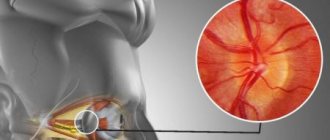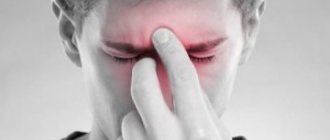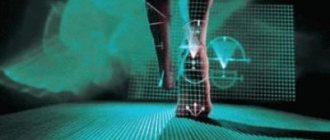Home > Fingers go numb
Numbness in the fingers can be caused not only by compression of the median nerve, as in carpal tunnel syndrome, but also by compression of the ulnar nerve. In the latter case, the fingers involved in the process change. The ulnar nerve provides sensory innervation to the fourth and fifth fingers, that is, the little and ring fingers. It is they who become numb when conduction along the ulnar nerve is disrupted.
The weak point for the ulnar nerve is, oddly enough, the elbow. At this level, the nerve passes in a special groove between the internal epicondyle and the olecranon process. Because the ulnar nerve runs posterior to the elbow (unlike the other two, the radial and median), its stretch is significantly greater when the elbow is flexed.
If the nerve can slide normally in its groove, then its function does not suffer. And if, for some reason, it is pinched by the surrounding tissues and sliding does not occur, then it is stretched and damaged.
Reasons for the development of the syndrome
The ulnar nerve passes through the canal of the bone, so it is quite well protected from external factors. But if changes occur in the bone canal or in its walls that surround the nerve, compression of the nerve may begin. This process will be accompanied by specific symptoms.
Why does cubital tunnel syndrome develop? This can occur due to overstretched tendons and ligaments, which leads to a short-term cessation of blood supply and, naturally, a reduction in the supply of nutrients. If a pathological factor affects the tissue for a long time, then a structural disorder will occur: loosening, swelling, thickening. As a result, all the free space in the tunnel is filled and compresses the nerve, causing motor conduction to be impaired.
Pressure on the elbow can be applied under circumstances such as:
- Traveling in vehicles with frequent use of the armrest.
- Working at a computer in which the elbow constantly hangs down.
- Significant damage to the elbow area.
- Fractures of the humerus or radius.
- The growth of a cyst, spur, or osteophyte that blocks the canal and compresses muscle and nerve fibers.
Cubital tunnel syndrome is caused by the improper use of antibiotics, in addition, the use of vasodilators and diuretics.
Inflammation of the cubital canal in most cases develops in areas of greatest influence of physical activity. But at the same time, there are certain categories of patients for whom the risk of developing this syndrome is higher than others:
- Persons whose activities involve monotonous and constant flexion and extension. These are painters, plasterers, violinists, guitarists, tennis players, hairdressers.
- Persons over the age of 50 who have already begun to experience age-related changes in bone tissue.
- Patients with diseases of the endocrine system, in which it is not possible for damaged tissues to fully recover.
- Patients with autoimmune diseases.
- People with a genetic predisposition to diseases of the musculoskeletal system.
Nerve transposition: features of the procedure
Another procedure that is often performed by surgeons. During the operation, the pinched nerve is moved to a freer space (deeper or forward of the muscles).
This technique has a number of advantages. Most often, the functioning of the limb can be restored completely. The risk of relapse is minimal. There are also disadvantages - cases of tissue scarring have been reported.
What symptoms bother the patient?
The nerve is compressed slowly, gradually, and the symptoms of the pathology increase in the same way. As soon as everything starts and the compression is still weak, then there is no cubital tunnel syndrome yet. During this period, the patient feels practically nothing except discomfort in the elbow area after physical activity.
Due to the decrease in the lumen of the canal, the symptoms intensify, and the person feels the following manifestations:
- Local increase in pain after exercise.
- Sometimes pain can begin at rest, for example during night sleep.
- Often there is numbness in distant areas that are located at a distance from the area with pinched nerve.
- If a ligament or muscle is sprained, the pain intensifies. The pain also increases when the affected area is tapped.
- When the symptoms become stronger, then stiffness occurs in the affected joint.
- The muscles in the area of the affected nerve become significantly weaker.
- Muscle atrophy is noted. This is observed when parallel muscles are tense, where the affected organ has reduced tone.
The most striking sign of nerve inflammation is pain not only in the elbow, but also in the shoulder, shoulder blade, and back area. This prevents making a correct diagnosis. Often this syndrome becomes chronic and is not life-threatening at all; the disease can occur with periods of exacerbation and relief.
Although all unpleasant symptoms can cause severe discomfort to the patient, constant pain, nervous tension, irritability - all signs can intensify and bother the patient.
What is the essence of medial epicondylectomy?
In some cases, patients are prescribed an epicondylectomy. This is a much more complex procedure, the essence of which is to remove part of the elbow joint. Such manipulations help to widen the channel through which the nerve passes, which helps relieve pressure.
It is worth noting that some of the functions of the hand are lost even with a properly conducted recovery period. The rehabilitation period after such an operation is long and quite painful. The procedure is associated with other risks - bone growth, muscle weakening.
How is diagnosis carried out?
In case of tunnel syndrome, the diagnosis of the disease is carried out by a neurologist, whose task includes:
- Questioning the patient about the possible causes of this pathology: whether there have been injuries in the past, what nature of the pain, what movements cause it.
- Examination of a sore elbow joint.
- Determining the most painful areas.
- Identification of the paths of the pain impulse and its intensity.
- Carrying out tests for the functionality of the radial nerve.
Usually this is enough for an experienced and qualified doctor to diagnose ulnar nerve tunnel syndrome.
In complex or advanced forms of the disease, the doctor may additionally prescribe an examination using special devices: EMG - electromyography, ENMG - electroneuromyography.
X-rays, MRI, ultrasound can be prescribed only if the nerve has been pinched by bone growths: spurs, osteophytes, deformed cartilage that were formed after fractures, arthritis, gout and other joint diseases.
Rehabilitation and recovery period
With the help of medications, you can get rid of inflammation, normalize blood circulation and tissue trophism. Further, additional measures are introduced into the treatment regimen.
In particular, patients are often recommended therapeutic massage, which helps relieve muscle spasms, increase their tone, and improve blood flow.
In some cases, doctors prescribe wearing a special splint. It is especially important to wear this device at night to reduce the risk of injury while sleeping. Sometimes short-wave heating of the elbow area is also effective.
Most often, conservative treatment lasts about 1-2 months. If you follow all the doctor’s recommendations, you can get rid of inflammation, relieve pressure on the ulnar nerve and restore mobility to the elbow joint.
Therapeutic measures
Neutralization of the disease primarily involves treating the pathological process. In addition, it is imperative to relieve pain while preventing complications in the form of increasing infringement.
Conservative therapy
Drug therapy includes:
- prescribing NSAIDs (anti-inflammatory) drugs, which, in addition to neutralizing the inflammatory process, provide good pain relief. Such drugs include Nimesulide, Ortofen, Ibuprofen, Ketorol, etc.;
- to normalize nerve conduction and circulatory processes, it is recommended to take B vitamins (tablets or injections);
- To stabilize the immune system, as well as neutralize the inflammatory process, intravenous administration of calcium chloride is prescribed. The administration of this drug should be performed with extreme caution and only by highly qualified medical personnel;
- in case of severe development of symptoms, hormonal agents (Prednisolone, Hydrocortisone, etc.) can be prescribed, which can be injected directly into the affected area or used externally, in the form of ointments, creams and gels.
An important condition for treatment measures for carpal tunnel syndrome is a temporary limitation of physical activity, which provokes an increase in such symptoms. For 1 month, it is recommended to apply anti-inflammatory drugs (Diclofenac, Voltaren, etc.) to the affected area, regardless of whether a pain symptom is present or not. This is necessary in order to relieve the inflammation and swelling of the muscles that usually accompany this disease.
Rehabilitation activities
If the patient’s condition significantly improves (5-6 weeks) after treatment, it is recommended to carry out restorative measures with the help of massage and exercise therapy.
A special elbow rest helps relieve tension
Rehabilitation exercises can be performed directly by the instructor or by the patient himself. To carry out the procedure yourself, it is recommended to fill the bath with warm water and lower your hand into it (just below the wrist). Then you need to squeeze your palms, performing slow rotational movements. After this, the hands are wrapped in a soft, warm towel to ensure immobility.
No special preparation is required for massage. Massaging begins from the finger area, moving to the outer side of the palms, gradually moving upward (to the center of the inner part of the hand, as well as the forearm). The movement is repeated 2-4 times, after which it is necessary to apply dry heat to the hand for 20 minutes.
Acupressure for pain in the elbow joint
In addition to massage and gymnastics, the doctor has the right to prescribe the wearing of a special splint, which is used to block the elbows during night sleep, and short-wave heating.
Conservative therapy can significantly improve the patient's condition within 1-1.5 months. As an auxiliary method of treatment, you can use folk remedies, for example, herbs that are added to medicinal hand baths, but it should be remembered that this method of treatment can only be used with the permission of a doctor. Otherwise, the patient's general condition may worsen.
Surgery
If therapeutic treatment is ineffective and symptoms progress, the issue of surgical intervention is decided. At the initial stage of the operation, decompression is performed - excision of the thickening of the walls of the cubital canal, followed by dissection of the tendon arch and a partial incision in the humeral epicondyle.
Elbow surgery
At the final stage, the transposition of the nerve endings is done. Next, the nerve is removed through the cubital canal and placed in the space between the fatty tissue and the muscle.
Postoperative rehabilitation measures
After surgery, the arm is fixed with an elastic bandage or a special splint to prevent sudden movements and stress.
The postoperative recovery period lasts for 1 month, after which you can begin rehabilitation measures, which include:
- passive movements in the elbow joint with complete muscle relaxation;
- isometric actions with muscle tension, but no physical activity of the joint;
- movement of joints with simultaneous muscle tension;
- the use of special weights for muscle tension;
- clenching and unclenching a fist;
- rotation of a clenched fist in different directions;
- alternately joining the hands in a lock with a strong squeeze of the fingers.
It is recommended to perform exercises at least 2 times during the day. In addition, swimming shows good performance. In water, muscles relax as much as possible, which increases blood flow and accelerates the regeneration processes of damaged areas.








